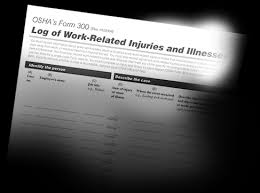WASHINGTON – The Occupational Safety and Health Administration today issued a proposed rule to improve workplace safety and health through improved tracking of workplace injuries and illnesses. The announcement follows the Bureau of Labor Statistics' release of its annual Occupational Injuries and Illnesses report, which estimates that three million workers were injured on the job in 2012.

"Three million injuries are three million too many," said Assistant Secretary of Labor for Occupational Safety and Health Dr. David Michaels. "With the changes being proposed in this rule, employers, employees, the government and researchers will have better access to data that will encourage earlier abatement of hazards and result in improved programs to reduce workplace hazards and prevent injuries, illnesses and fatalities. The proposal does not add any new requirement to keep records; it only modifies an employer's obligation to transmit these records to OSHA."
The public will have 90 days, through Feb. 6, 2014, to submit written comments on the proposed rule. On Jan. 9, 2014, OSHA will hold a public meeting on the proposed rule in Washington, D.C. A Federal Register notice announcing the public meeting will be published shortly.
The proposed rule was developed following a series of stakeholder meetings in 2010 to help OSHA gather information about electronic submission of establishment-specific injury and illness data. OSHA is proposing to amend its current recordkeeping regulations to add requirements for the electronic submission of injury and illness information employers are already required to keep under existing standards, Part 1904. The first proposed new requirement is for establishments with more than 250 employees (and who are already required to keep records) to electronically submit the records on a quarterly basis to OSHA.
OSHA is also proposing that establishments with 20 or more employees, in certain industries with high injury and illness rates, be required to submit electronically only their summary of work-related injuries and illnesses to OSHA once a year. Currently, many such firms report this information to OSHA under OSHA's Data Initiative.
Note that the construction industry is one that is in the list of these designated high-hazard industries, meaning that virtually all construction employers with 20 or more employees would be required to submit their 300A log directly to OSHA each year.
OSHA plans to eventually post the data online, as encouraged by President Obama's
Open Government Initiative. Timely, establishment-specific injury and illness data will help OSHA target its compliance assistance and enforcement resources more effectively by identifying workplaces where workers are at greater risk, and enable employers to compare their injury rates with others in the same industry. Additional information on the proposed rule can be found at
http://www.osha.gov/pls/oshaweb/owadisp.show_document?p_table=FEDERAL_REGISTER&p_id=24002 and
http://www.osha.gov/recordkeeping/proposed_data_form.html.
Under the Occupational Safety and Health Act of 1970, employers are responsible for providing safe and healthful workplaces for their employees. OSHA's role is to ensure these conditions for America's working men and women by setting and enforcing standards, and providing training, education and assistance. For more information, visit
http://www.osha.gov.